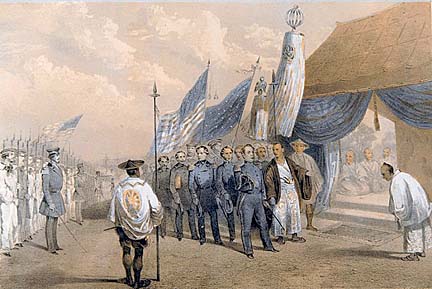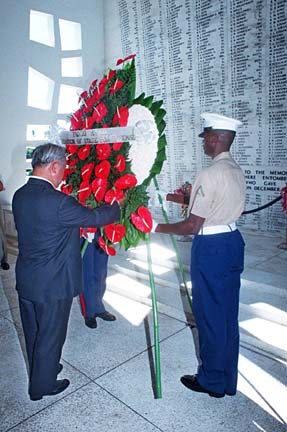
NAVY HISTORICAL CENTER
Commodore Perry meets members of the Imperial Commission at Yokohama in 1853.
U.S., Japan endure
through ups and downsThe two nations are marking
150 years of trade and turbulence
On July 8, 1853, Commodore Matthew Perry's four black ships steamed into the Japanese harbor of Uraga (Yokosuka) to deliver a letter from U.S. President Millard Fillmore asking that Japan open itself to American commerce and consular representation. The event was highly significant for both countries. For the United States, its forceful intervention on the western side of the Pacific presaged the leading role that it would come to play in the region and marked its emergence as a global power. The impact was much greater for Japan, abruptly ending a long era of seclusion and triggering a major social and political upheaval as the country embarked on the modern era.
One hundred and fifty years later, and despite an often turbulent history, the relationship between the two countries has become among the more successful bilateral relationships in the world. Accordingly, both countries are celebrating the anniversary of the establishment of their relationship with many cultural, culinary, sports and educational events. In Honolulu last week, both the Academy of Arts and the East-West Center annual dinner featured Japan and honored one of Japan's living cultural treasures, Grand Teamaster Genshitsu Sen of the Urasenke tea tradition. Other American cities from New York to Portland as well as many cities in Japan will be hosting special events during the coming year to commemorate the 150th anniversary.
The achievements in Japanese-American relations stand out vividly against two negatives: the lack of the historical and cultural depth that characterizes U.S.-European relations and the frequent clashes of territorial, political and economic interests during much of the past century.
STAR-BULLETIN / 1997
The healing of war wounds between America and Japan continues with frequent visits by Japanese dignitaries to Pearl Harbor, the scene of the two nations' greatest rift. In 1997, Fumio Kyuma, then-Minister of State for Defense, laid a wreath at the Arizona Memorial, paying tribute to U.S. sailors who died during the Dec. 7, 1941 Japanese attack on Pearl Harbor.
In 1853, Japan was terra incognita to the United States and the rest of the world, known only through the tiny window open to Dutch merchants in Nagasaki harbor and the extremely rare Japanese who had left the country by accident or misfortune. One was the remarkable shipwrecked fisherman "John Monjiro," who at age 14 was rescued from a small Pacific island by a passing American whaling vessel and taken through Hawaii to New England, becoming the first Japanese resident of the United States in the 1840s.
After Japan's opening, people-to-people relations grew. As Japanese began to come to Hawaii and the United States in larger numbers in the 1880s and 1890s, they were welcomed as hard and productive workers, just as Americans were being welcomed in Japan as teachers. But prejudice against the Japanese and other Asians built up on the mainland, leading to restrictive immigration laws. Also, by the turn of the century, Japan and the United States were both expanding their interests and territories in Asia and the Pacific, setting the stage for the later military confrontation that so deeply disrupted relations.
The end of World War II and military-dominated government in Japan opened a new, more promising era of Japanese-American relations. What began as a foreign occupation evolved into a voluntary alliance supported by the vast majority of both countries' citizens.
As products and people began to move much more freely, each country became a more familiar quantity to the other. Names like Sony, Panasonic and Toyota became as familiar to Americans as IBM and Ford; sushi take-out restaurants spread to large and then medium-sized American cities; and American franchises popped up all over Japan. Increasingly it seemed as though most middle-class Japanese had visited Hawaii.
The very intimacy of the postwar relationship inevitably led to stresses and strains. Some Japanese regarded the U.S. alliance as a constraint on a more independent Japanese foreign policy. U.S. efforts to protect segments of its economy from Japanese competition and to open the Japanese market were regarded in Japan as "Japan bashing." Americans worried that Japan's rise would cost the United States jobs and incomes, that America would become too economically dependent on Japan's investment, or that competitive pressures would force Americans to adopt a Japanese form of capitalism. After the collapse of the Soviet Union, public opinion polls suggested that for a brief period Americans regarded Japan as their No. 1 foreign threat, although of a completely different kind. In the early 1990s, the citizens in each country saw the other as the cutting edge of globalization forces that were unfamiliar, threatening and potentially socially destabilizing.
Despite this, the 150th anniversary finds Japan-America relations better than they have ever been. Japan's decade-long economic problems have helped most Americans to understand better something that Hawaii already knew -- a healthy and growing Japanese economy is a benefit to the United States rather than a threat. At the same time, economic forces have been gradually changing Japan's economy and corporate governance, making it more compatible with the United States. The two countries have increasingly found common ground on a variety of concerns ranging from issues related to China's regional integration and North Korea to the war on terrorism.
The history of the relationship tells us that there is no inevitability about an upward trend. U.S.-Japan relations require constant tending. Several challenges lie ahead.
>> With Japan's economic difficulties, general American interest in Japan has declined. Without broad-based engagement, the relationship can become dominated by special interests. Moreover, the United States simply cannot afford to neglect a country that still has by far the world's second-largest economy and that is our foremost ally in the region.Hawaii is on the cutting edge of virtually all aspects of the U.S.-Japan relations, from military links to tourism and ethnic ties. No place in the world is more dependent on these good U.S.-Japan relations.>> A legacy of American expectations of Japanese deference and Japanese expectations of American benevolence lingers. A healthy, modern relationship must be a true partnership based on similar values, mutual interests and realistic expectations.
>> A strong fabric of U.S.-Japan relations requires a real interweaving of the two societies as a whole, not just cooperation between the two governments. For this reason, private business connections, tourism, and educational and cultural activities such as those of the East-West Center, the Japan-America Society of Hawaii, our universities and many other organizations become so critically important.
Thus it was fitting that Governor Lingle was the first American VIP visitor to Japan in the anniversary year that began this month. We should take the lead in celebrating the achievements in U.S.-Japan relations and in working to strengthen them.

